The sound of Tin Pan Alley, both literal and metaphorical, marked a major evolution in American music. It was a place where creative talent met aggressive marketing, and where popular music began to function as a fully developed commercial industry.
Song pluggers played a crucial role in the business. These were musicians hired to perform new songs for store customers, theater owners, and vaudeville acts, effectively serving as live advertisements. In the years before recorded music became widespread, live performances were the primary way people encountered popular songs. While Tin Pan Alley songwriters continued to compose in styles reminiscent of earlier composers like Stephen Foster, the marketing strategies they employed were far more aggressive and wide-reaching. In this new era, the “plugging” or promotion of a song was often as important as writing it. Song pluggers, employed by publishing companies, were responsible for making songs known to the public through highly creative and often relentless promotional tactics. By 1910, Americans were buying approximately 30 million copies of sheet music per year, a testament to the industry’s size and cultural reach.
Song pluggers would perform new songs in music shops, five-and-dime stores, and even on the streets, hoping to generate buzz and encourage sheet music sales. They carried chorus slips, printed lyrics of a song’s refrain, which they distributed in taverns and theaters so that patrons could sing along. They rented hay wagons, bolted pianos to the flatbeds, and stationed them outside theaters, amusement parks, and sports arenas to catch crowds as they exited.
Pluggers were also known to pay bandleaders to feature their songs at dances, bribe waiters in restaurants to hum or sing the tunes to customers, and hire boys to sing the songs in public spaces while selling sheet music like newspapers. At silent film screenings, boys would jump up and sing during reel changes to promote the latest songs. One of the most effective and targeted promotional methods involved vaudeville performers.

